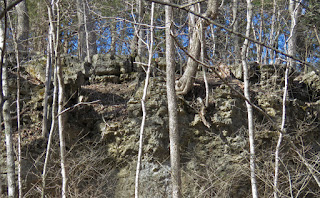Dick and I belong to the National Association of Interpreters. When I tell people this, the first thing they ask is how many languages I speak. I smile and say I speak the language of Nature, and my job is to help people understand and relate to nature. The Sunny South includes interpreters from the southeastern part of the country, and most of them work for parks of some sort, although this year we had several people from zoos as well. Each state in the region takes turns hosting an annual conference where the interpreters can refresh their goals and skills. In fact, we both were presenters at this year's conference, and it was a challenge to prepare a 45 minute presentation using skills I haven't intentionally used for several years. You know, we all get into habits and just do things the same way. I was afraid no one would come to my presentation on raptors, but 13 people attended. Whew!
 |
| Kentucky Glade Cress |
In additional to sitting in a room, we had opportunities for several field trips. We went to look at some Bullitt County glades. A "glade" is an area of very poor soil surrounded by limestone in which little will grow. However, a few glades in Bullitt and Jefferson Counties are the only place in the WORLD where you can find Kentucky Glade Cress. It is a very small plant that only grows in this poor soil that is dry and hot much of the year. This glade belongs to the Kentucky State Nature Preserves, so it is protected. Our reason to visit it was to discuss what to do with it. On one hand, it would be nice to let people come and see this rare plant. On the other hand, you don't want people tramping on it, which they would since it is so small and hard to identify. On the other hand, if protected too well, the cedar trees and other plants will take over the area, making it too "nice" for this tough little plant to grow.
 |
| Purple Cress |
No trails in the preserve, so we bushwhacked down to the creek to see what might be popping up in the early spring, accompanied by a neighbor's dogs. The creek was lovely, singing it's way down the valley. Purple cress was full of buds and ready to bloom, but on Saturday, the temps dropped back to winter ranges.
The Bullitt County limestone has a lot of magnesium in it, but wears down from the acidic rainfall.
 |
| Gypsum Flowers |
On Thursday, I took the all day trip to Mammoth Cave since I haven't been there for years. The park ranger led us into the man-made back door of the cave system and down 200 steps into Cleaveland Cave. This is a dry cave without the features most people expect. Sandstone caps over the limestone keep rainwater from percolating through. This cave is the dried out river bed of a stream that now runs lower underground. We were about 260 feet below the surface. However, the ceilings were covered by gypsum growing through small cracks, and curling into beautiful flower formations. The ranger did a great job interpreting both the geological aspects of the cave, and the history. Tours started in 1816, led by Stephen Bishop, a slave. The graffiti on the walls is not from modern visitors, but from people touring before it became a National Park in 1941. The sooty coloring of the gypsum is from torch and lantern smoke.

We walked on a nice smooth path created by the Civilian Conservation Corps in the 1930's, and I could not imaging walking across all the chunks of stone on the floor of the tunnel. Mammoth Cave is at least 400 miles long, and they are still exploring it. When Bishop explored the cave, he would write his name and the date on the walls, to indicate his path back out again.
Nick was another slave who explored and led tourists into Mammoth Cave. Here is a tribute to him from 1857. My cell phone took better pictures in the poor lighting than my good camera did. Glad I had both. Three days later, my calves are still aching from the climb up and down all those stairs!
After lunch, we went on another ranger led hike to Holton Cemetery, which is not open to the public, to learn about the people who lived in the area. When ever you see daffodils blooming, you know there used to be a homestead. The rangers made these people who were forced from their homes come alive for us. I was struck by the isolation of the home sites. Imagine trying to give birth with no one closer than a mile away. There were no nearby towns.
 |
| Ky State Champion White Pine Tree |
We were introduced to Edley “Red Buck” Esters (1883-1969), who once owned and eventually sold his acreage to the park in the mid 1930s. His living memorial pine tree (planted about 100 years ago) now measures nearly 12 feet in circumference and stands 13 stories high. Red Buck was known for his "hollerin" either to call in the live stock, or sing really loud. The ranger had an old recording of Red Buck made during a Mammoth Cave homecoming many years ago. As the park staff finds these old cemeteries, or names inside the cave, they do historical research that makes these individuals come alive to park visitors. In fact, there are
cemetery databases where they can be traced. These conferences are always great fun. Next year's will be on the Outer Banks of North Carolina, and we plan to attend.









1 comment:
Glad to see this about Red Buck. He is my great grandfather and passed away when I was nine. I can still see him though
Post a Comment